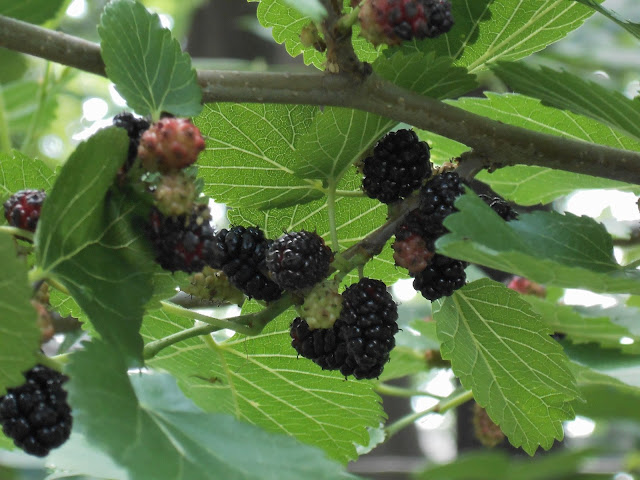 |
| Each purple square marks thelocation of a mulberry tree. There are many others in the nearby alleys and vacant lots! Click map to enlarge. |
Background: I have noticed that mulberries are ubiquitous here in St. Louis. They come up through the cracks in the street, out of mortar joints in walls, sprout in gutters, fence lines, flower beds, just about any place you can imagine. They are very difficult to uproot after they are more than a few months old. As a result, there are probably millions of mulberry trees in St. Louisans' fence lines and borders. Said trees have been snipped off year after year until they develop a large root/ stump and a fairly small canopy.
 |
| Growing out of a concrete wall! |
 |
| I'm discussing the little shrubby thing in the middle of the picture, not the real tree in the background! |
My neighbor has a huge mulberry tree in his back yard and it is always loaded with large luscious berries. Said neighbor, though, is a bit difficult and rather than risk unpleasantness, I have been keeping my eyes out for other trees on my walks and bike rides. Sticking to the 'keep it local' ethos, I decided to follow the Highway 44 fence line and see how many mulberries I could find.
What I found was astounding. Mulberries may be the most common tree species growing on this fence line. As far as I can tell they are nearly all red mulberries (Morus rubra - the native variety). There is a wide range of variation in fruit size, flavor, and ripeness stage. Large fruits are less common than small fruits, but most are fairly sweet. I guess that tells us which characteristic the birds are going for when they eat the fruits (and then later disperse the seeds).
I have since learned that mulberries are a member of the Rosales order of flowering plants. This means they share a level of kinship with roses, blackberries, apples, hawthorns, and (OMG!) marijuana. To my taste, the flavor is mildly sweet, with hints of blackberry and blueberry. Some of the sweetest fruits were also the smallest.
How can I have lived here for 13 years and not known about this little slice of life? Needless to say, by dark, my consciousness regarding mulberries was transformed. I have not previously considered the place of mulberry in the aboriginal landscape of St. Louis. I know this tree does not survive fires well so it was probably less common on the prairies than it is today. This species may have been confined to forested locations and along waterways. I do not recall having seen very many reports of mulberry seeds from local archaeological excavations.
My total haul for the day was about a gallon of berries. I rinsed them twice, made a buttery crust from scratch and baked a pie. It tasted much like the fresh berries - blueberry/ blackberry flavor. This morning after my breakfast of steel cut oats and maple syrup I had another slice of pie. Amazing! Definitely let this pie cool before eating. Wow!
I still have a big bowl full of berries so I'm going to muddle and cook them down into a syrup that I will seal into small jars for pouring over cake, ice cream, yoghurt, who knows what all? Maybe later this weekend I'll gather some more for jam. The berries appear to be ripening in stages this year; some trees have no ripe fruits at all yet. The season may be a long one!
I've decided that my battle with the old man in the fence line is now at a temporary truce. I will let him grow and fruit. If the fruits are big and tasty he stays. If not, the battle will continue. Regardless, I have a new respect for these trees. I used to think they were an invasive species from Asia. Although there are introduced white mulberries, we seem to have plenty of our own variety here in St. Louis. I am adding this one to foraging schedule. Next up on the schedule: service berries!



When I was a kid, it wasn't called foraging, and it was my job to pick mulberries for my mom very summer. I recall purple hands and feet! Thanks for the map. I can't wait to pick this summer.
ReplyDeleteI grew up eating mulberries from a tree on our Iowa farm. The easiest way to pick them is to lay an old sheet on the ground under the laden branches. Then use a long pole to tap the branches. They rain down like hail! Lots easier than picking by hand.
ReplyDelete